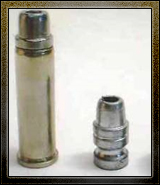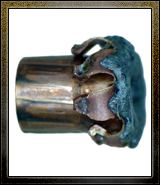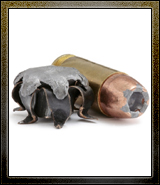 |

Bullets
Modern bullets come in two basic types with tons of sub categories. These two basic types are cast solid lead and composite (usually a pairing of lead core with different types of copper jackets). Bullets are measured to two major specifications, one being weight the other caliber.
Weight is not important unless you are a highly experienced or precision shooter. Because of this we are going to forgo any explanation of bullet weight for simplicities sake. Just know that bullets are weighed in grains, and heavier ones tend to hit harder.
Caliber is the major measuring specification used for bullets. It is the approximate diameter of the bullet usually measured in inches. Caliber is also measured in millimeters; however, the term 'caliber' is often dropped from the description. For example, you can have a 45 'Caliber' bullet, which is approximately 0.45 inches in diameter, or a 9mm bullet, which is approximately 9mm in diameter.
Important: It is important to note that bullet nomenclature is somewhat inconsistent when trying to determine what bullets you need for a specific type of gun. For example, you might think that a '.38 special round' is 0.38 inches in diameter, and therefore 38 caliber, however, the bullet on a .38 Special is actually 0.357 inches. The .38 Special Round is given this name to distinguish it from a standard .357 Round, which is slightly shorter overall (bullet plus casing).
Cast Bullets
|
 |
|
A cast, solid lead,
38Special
|
Cast bullets are made of solid lead, and are typically used in old style revolvers and small caliber rifles such as the .22L (Long) and .22LR (Long Rifle). Cast bullets come in several different shapes including Flat Nose (FN), Round Nose (RN), and Spitzer (Sp). Each shape lends itself to different uses. For example, flat nose bullets tend to mushroom out much sooner due to the increased surface area of their flat tips. Spitzer bullets have a more conical shape resembling a modern jacketed bullet. These tend to penetrate more than Flat, or Round nose bullets, and do less tissue damage.
As far as the undead go, cast bullets will do the job, and put down the enemy with a nice shot to the head. However, Cast bullets are also fairly soft and lack the penetration power of jacketed bullets. Cast bullets have been known to ricochet, and even stop on or around bone. This makes them somewhat not ideal for zombie warfare. It is hard enough to hit a moving target in the head, let alone having to worry about you bullet bouncing off the top of their head. It is also important to note that solid lead bullets are not effective when attempting to shoot through obstacles such as heavy brush, walls, glass, and body armor.
Composite (Jacketed) Bullets
|
 |
|
A jacketed bullet after it
has struck a target
|
Jacketed bullets typically have a lead core coated in a copper jacket, and allow for much higher muzzle velocities than cast lead bullets. The outer jacket can completely cover the lead core, or in most cases, partially cover the core of the bullet leaving part of it exposed. Jacketed Bullets come in tons of different types (approximately 80), some standard, and some proprietary designs unique to the bullet manufacturer. Since there are so many we are only going to go over the ones you will commonly find in ammo stores, and commonly find in scavenged weapons. You can find a  full table of bullet types here, both universal and proprietary. The table also includes a helpful guide on determining the effectiveness of each bullet type against the undead. full table of bullet types here, both universal and proprietary. The table also includes a helpful guide on determining the effectiveness of each bullet type against the undead.
The overall look of a bullet tends to give away what it is, but to make things even simpler, bullets are assigned a one to four letter abbreviation that lets you know just what it is. Some common examples are FMJ (Full Metal Jacket), AP (Armor Piercing), and JHP (Jacketed Hollow Point).
FMJ
The most common bullet you are likely to find is the FMJ (Full metal Jacket). Its name is fairly self-explanatory; it is a solid lead core bullet, fully jacketed in a copper shell. Civilian FMJ ammo is slightly different than military FMJ ammo. Civilian FMJ ammo tends to have a thicker copper shell, and therefore penetrates very deep before deforming, or mushrooming, and sometimes exits without deforming at all. This leaves much less tissue damage than is desirable, and is not the greatest for zombie warfare. Military spec. FMJ ammo however is slightly different. Due to the Hague Convention, the military is essentially banned from using expanding ammunition, such as JSP (Jacketed Soft Point), and JHP (Jacketed Hollow Point) ammo. To get around this, the military uses FMJ ammo with very thin copper walls, this causes them to slightly expand, and often splinter quickly. Military spec. FMJ ammo is ideal for zombie warfare because it has the penetrating power of an FMJ, while still possessing the ability to cause heavy tissue damage, literally scramble brains.
On a side note, deep tissue penetration may not necessarily be a bad thing. If a large number of zombies are in a tight grouping, FMJ bullets have the ability to go right through one target, killing it, and into another, possibly killing that one too. It's not something to bank on, but it is still a possibility.
JHP
|
 |
|
A Jacketed Hollow Point Bullet
Bullet
|
JHP or Jacketed Hollow Point bullets are about the best available for killing zombies. They posses a hollowed out pit at their nose, which is designed to expand upon entering a target causing the maximum amount of tissue damage. Also, the lack of weight at their nose cause their center of gravity to be pushed much farther back increasing flight stability, accuracy. JHP bullets are often used by law enforcement agencies, and by civilians for home defense. The rounds expand quickly giving them a much larger surface area causing them to pack a greater punch, giving them a lot of stopping power. Since they have less penetration than FMJ ammo, they often stay lodged inside the intended target, or at the very least, lose a lot of their power on the way through, this makes them much safer to use in the presence of bystanders.
Note: Jacketed bullets that feature the abbreviation HP (Hollow Point) are the same as JHP (Jacketed Hollow Point) bullets. The J, which stands for Jacketed, is redundant, and therefore often omitted.
JHC
JHC or Jacketed Hollow Cavity Bullets are nearly identical to JHP bullets. The only difference is that JHC bullets have an unusually deep cavity in their nose rather than the smaller pit associated with JHP ammo. This larger cavity causes extreme expansion and sometimes fragmentation on impact. If you happen to get your hands on these, they would be excellent for zombie warfare. However they are not commonly manufactured, and are usually only available in pistol rounds.
JSP
|
 |
|
A Jacketed Soft Point Bullet
Bullet
|
JSP, or Jacketed Soft Point bullets, are a very common round especially with game hunters. Think of them as a combination of FMJ and JHP. They still expand like JHP ammo, however penetrate much farther, similar to FMJ ammo. Typically, they will be copper jacketed with 5-20% of the tip being exposed lead. JSP ammo performs great in military spec. weapons since they have the same basic shape as FMJ ammo and are easily fed from their magazines. (Military weapons are made to fire FMJ ammo exclusively, and therefore may experience jams while using flatter nosed hollow point ammo.) JSP bullets are a very nice style of 'hybrid' ammo. They still expand like Hollow point ammunition, but allow for greater penetration and versatility.
Note: Another type of JSP ammo exists called the JFP or Jacketed Flat Point. They are the same as JSP with the exception that they have a squared off flat nose. This characteristic gives them less penetration and more stopping power than a standard JSP bullet.
AP
AP, or Armor Piercing bullets, are typically fully jacketed or semi-jacketed with a soft point, and feature a hard metal 'penetrator' inside them. The penetrator is spike-like post made of hardened steel or tungsten carbide. Basically, you can't shoot a bullet made completely of steel and other hard metals, as they will utterly ruin the barrel of the firearm. They also wont expand on their way down the barrel making for a poor seal, and reducing performance. Instead, AP bullets use a core made of a dense hard metal to pierce armor, but are jacketed is softer, more firearm friendly, alloys.
AP bullets have no real use against zombies. Sure like any other bullet, they will do the job, but they are not ideal by any means. They rarely deform, have low stopping power, and are designed to go through things, not stop them.
AP bullets are typically illegal, as they make law enforcement body armor effectively useless. While scavenging for ammo, you may find them in military weapons, and major metropolitan law enforcement weapons. (Think places with S.W.A.T. teams.) If you happen to get them, they have their uses, but don't try using them as your main source of ammo.
|
 |